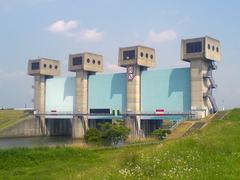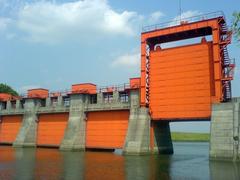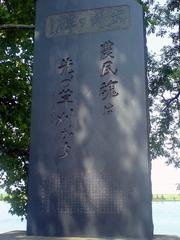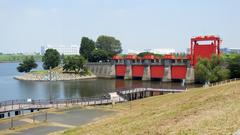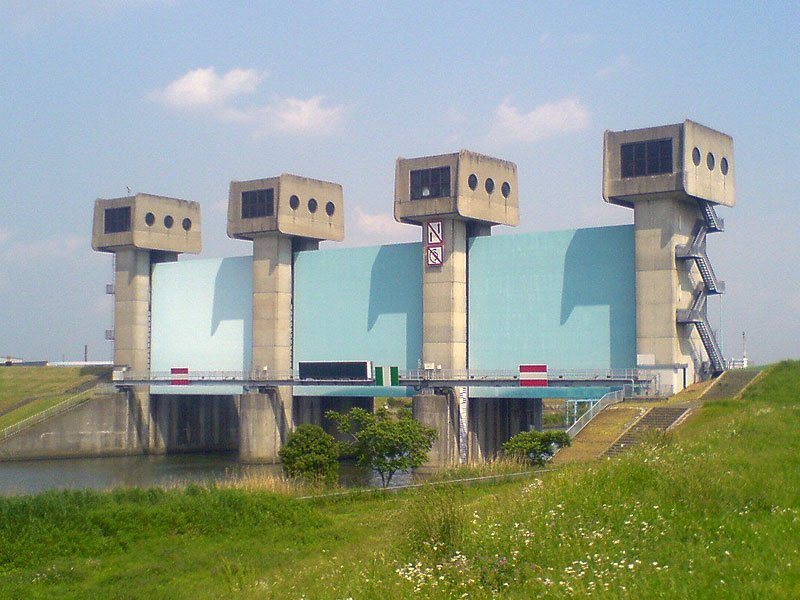
Visiting Old Iwabuchi Watergate in Tokyo: Hours, Tickets, and Travel Tips
Date: 24/07/2024
Introduction
The Old Iwabuchi Watergate, also known as the Iwabuchi Sluice Gate, is a significant historical and engineering landmark in Tokyo, Japan. Constructed in 1924, this watergate was part of Tokyo’s early efforts to manage the water flow of the Arakawa and Sumida Rivers to prevent frequent and devastating floods. Located at a strategic confluence, its robust steel structure and manual operation system were marvels of early 20th-century engineering (Mainichi). Over the decades, the Old Iwabuchi Watergate has withstood natural calamities, including the 1923 Great Kanto Earthquake and numerous typhoons, proving its resilience and functional design (Japan Policy Forum). Today, it stands not just as a piece of historical infrastructure but as a cultural symbol of Tokyo’s resilience and ingenuity. This guide will provide comprehensive insights into the watergate’s history, its significance, and practical information for visitors, ensuring a fulfilling experience at this iconic site (Tokyo Fox).
Table of Contents
- Introduction
- History of Old Iwabuchi Watergate
- Visiting Information
- Nearby Attractions
- Travel Tips
- FAQ
- Conclusion
History of Old Iwabuchi Watergate
Origins and Construction
The Old Iwabuchi Watergate, also known as the Iwabuchi Sluice Gate, is a historical structure located in Tokyo, Japan. It was constructed in 1924 as part of a broader initiative to manage the water flow and prevent flooding in the region. The watergate was built at the confluence of the Arakawa and Sumida Rivers, two significant waterways in Tokyo. The primary purpose of the watergate was to control the water levels and protect the surrounding areas from the frequent and devastating floods that plagued Tokyo during the early 20th century.
Engineering and Design
The design of the Old Iwabuchi Watergate was a marvel of early 20th-century engineering. It featured a robust steel structure with large gates that could be raised or lowered to regulate water flow. The watergate was equipped with a manual operation system, which required significant manpower to operate. The structure’s durability and functionality were tested over the years, particularly during heavy rainfalls and typhoons, proving its effectiveness in flood management.
Historical Significance
The Old Iwabuchi Watergate holds significant historical value as it represents the early efforts of modern Japan to tackle natural disasters through engineering and infrastructure development. The watergate played a crucial role in protecting Tokyo from floods, which were a common occurrence before its construction. Its successful operation marked a turning point in the city’s approach to disaster management and urban planning.
Role During World War II
During World War II, the Old Iwabuchi Watergate continued to serve its primary function of flood control. However, it also gained strategic importance due to its location and the critical role it played in maintaining the city’s infrastructure. The watergate was a target during air raids, but it survived the bombings, further cementing its status as a resilient and vital structure in Tokyo’s history.
Post-War Developments
After the war, Tokyo underwent rapid reconstruction and modernization. The Old Iwabuchi Watergate remained an essential part of the city’s flood control system. In the 1960s, with the advent of more advanced technology, the watergate’s manual operation system was upgraded to an automated one, enhancing its efficiency and reducing the need for manual labor.
Preservation Efforts
Recognizing its historical and engineering significance, efforts were made to preserve the Old Iwabuchi Watergate. In 1997, the watergate was designated as a Tangible Cultural Property by the Tokyo Metropolitan Government. This designation helped ensure that the structure would be maintained and protected for future generations to appreciate.
Visiting Information
The Old Iwabuchi Watergate is a popular tourist attraction, drawing visitors interested in the city’s engineering heritage and historical landmarks. Visitors can explore the structure and learn about its history through informative plaques and guided tours.
Visiting Hours
The Old Iwabuchi Watergate is open to visitors from 9:00 AM to 5:00 PM daily. It is closed on national holidays and during severe weather conditions.
Ticket Prices
Admission to the Old Iwabuchi Watergate is free. However, guided tours may have a nominal fee. It’s recommended to check the official website or contact the visitor center for the most up-to-date information.
Accessibility
The site is accessible to visitors with disabilities. There are ramps and designated viewing areas to ensure everyone can enjoy the historical landmark.
Nearby Attractions
While visiting the Old Iwabuchi Watergate, consider exploring other nearby attractions in Tokyo:
- Arakawa Nature Park: A serene park offering walking paths, playgrounds, and beautiful views of the Arakawa River.
- Sumida Aquarium: Located in the Tokyo Skytree Town, this aquarium features a wide variety of marine life and interactive exhibits.
- Tokyo Skytree: The tallest structure in Japan, offering panoramic views of the city from its observation decks.
Travel Tips
- Best Time to Visit: The best time to visit the Old Iwabuchi Watergate is during spring (March to May) and autumn (September to November) when the weather is mild and pleasant.
- Public Transport: The watergate is easily accessible by public transport. The nearest train station is Akabane Station, which is a short walk from the site.
FAQ
- What are the visiting hours for the Old Iwabuchi Watergate? The watergate is open from 9:00 AM to 5:00 PM daily, except on national holidays and during severe weather conditions.
- How much are tickets to the Old Iwabuchi Watergate? Admission is free, but guided tours may have a nominal fee.
- Is the Old Iwabuchi Watergate accessible to visitors with disabilities? Yes, the site is accessible with ramps and designated viewing areas.
Conclusion
The Old Iwabuchi Watergate is more than just a historical structure; it is a symbol of Tokyo’s resilience and ingenuity. Its construction, operation, and preservation reflect the city’s commitment to safeguarding its residents and infrastructure from natural disasters. As a cultural and educational landmark, the watergate continues to inspire and educate visitors about Tokyo’s rich history and the importance of engineering in urban development.
For more information on the Old Iwabuchi Watergate and other historical sites in Tokyo, visit the Tokyo Weekender.
